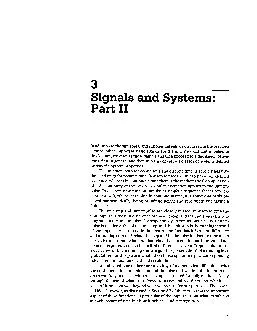/


In this lecture we discuss these signals and then proceed to a discussion of sys tems first in general and then in terms of various classes of systems defined by specific system properties The unit step both for continuous and discrete time is zero ID: 33435
Download Pdf The PPT/PDF document "Signals and Systems Part II In addition ..." is the property of its rightful owner. Permission is granted to download and print the materials on this web site for personal, non-commercial use only, and to display it on your personal computer provided you do not modify the materials and that you retain all copyright notices contained in the materials. By downloading content from our website, you accept the terms of this agreement.
3 Signals and Systems: Part II In addition to the sinusoidal and exponential signals discussed in the previous lecture, other important basic signals are the unit step and unit impulse. In this lecture, we discuss these signals and then proceed to a discussion of sys- tems, first in general and pulse. In discrete time the unit impulse is simply a sequence that is zero ex- cept at n = 0, where it is unity. In continuous time, it is somewhat badly be- haved mathematically, being of infinite of the impulse. As stressed in the lecture, the fact that it is a first difference and a running sum that relate the step and the impulse in discrete time and a derivative and running integral that relate them the continuous-time unit step and unit impulse that we do not attempt to ad- dress carefully in these lectures. This topic is treated formally mathematically through the use of what are referred to as generalized functions, which is a level of Signals and Systems 3-2 In this lecture we also introduce systems. In their most general form, sys- tems are hard to deal with analytically because they have no particular prop- erties to exploit. In other words, general systems are simply too general. We define, discuss, and illustrate a number of system properties that we will find useful to refer to and exploit as the lectures proceed, among them memory, invertibility, causality, stability, time invariance, and linearity. The last two, linearity and time invariance, become particularly significant from this point on. Somewhat amazingly, as we'll see, simply knowing that a system is linear and time-invariant affords us an incredibly powerful array of tools for analyz- ing and representing it. While not all systems have these properties, many do, and those that do are often easiest to understand and implement. Consequent- ly, both continuous-time and discrete-time systems that are linear and time- invariant become extremely significant in system design, implementation, and analysis in a broad array of applications. Suggested Reading Section 2.4.1, The Discrete-Time Unit Step and Unit Impulse Sequences, pages 26-27 Section 2.3.2, The Continuous-Time Unit Step and Unit Impulse Functions, pages 22-25 Section 2.5, Systems, pages 35-39 Section 2.6, Properties of Systems, pages 39-45 Signals and Systems: Part II S[n u [n] -u[n-i] 0 n O0I u [n] u [n -I] u [n]-u [n-1] TRANSPARENCY 3.1 Discrete-time unit step and unit impulse sequences. TRANSPARENCY 3.2 The unit impulse sequence as the first backward difference of the unit step sequence. Signals and Systems 3-4 TRANSPARENCY 3.3 The unit step sequence as the running sum of the unit impulse. TRANSPARENCY 3.4 The unit step sequence expressed as a superposition of delayed unit impulses. n u[n]= S 8[m] ms-C( n 0 8 Im] n O �nO 8[Im] Signals and Systems: Part II UNIT STEP FUNCTION: CONTINUOUS -TIME {0 t 0 u (t)= t � 0 u(t ) 0 t O ( t u(t) = u(t) as A -0 UNIT IMPULSE FUNCTION -du(t) 6(t) d d t 5(t) 6 (t) duA(t) dt = 5A(t) as TRANSPARENCY 3.5 The continuous-time unit step function. TRANSPARENCY 3.6 The definition of the unit impulse as the derivative of the unit step. A--0 Signals and Systems 3-6 TRANSPARENCY 3.7 Interpretation of the continuous-time unit impulse as the limiting form of a rectangular pulse which has unit area and for which the pulse width approaches zero. TRANSPARENCY 3.8 The unit step expressed as the running integral of the unit impulse. t) A 8 (t) o t k8(t) area = I height = " 00 " width = "0" area = I Signals and Systems: Part II 3-7 TRANSPARENCY 3.9 Definition of a system. x (t ) x (t) x[n] x[n] Continuous -time system 10y (t ) -0 y(t) y [n] -e y[n] TRANSPARENCY 3.10 Interconnection of two systems in cascade. Cascade XI O yI xi System yI ~ I y Y2a X1 yI Signals and Systems TRANSPARENCY 3.11 Interconnection of two systems in parallel. TRANSPARENCY 3.12 Feedback inter- connection of two systems. feedback xI x+y2 x2= Signals and Systems: Part II 6n(FYI Y- C-=E39 (tA P 10- -t s*'0 T N\ ERTAILMT( Xr~3 ML' -V ? T=crse o1 A N ~y) Co kA%'Q4' epevsJi on om,- * Pe ;o r or* Iud +0 At Time Or . S4s4cm can,'t aAtic.,(AA or * A, C4 -- 'Z C+) Same Fo da5rttv- TI me '\ Aeo "e ss. Eva"' Ie-. Ir3 CXn&-,3 t xt Et7) x Lo3 l i ex\ d Jr �-z -For everbouvded input 'de o ,p i b outnd ed ft.t -i-i-TILL--- ~rL' L-A2 I' ~ y+)IM 7 S4-obe. MARKERBOARD 3.1 C LO t C4 k , AC d~~c P. MARKERBOARD 3.2 'A (T)J-L .I j-A tr al LM) + ILVl GO11,11,0111-1 Signals and Systems 3-10 STvnvariaic. c (t)-w t) (~C~ Iyy3: ~ I Me Tvarw~ , O4 b 0 ) ,6,ts'cawst Lo Tvt1frl'w DEMONSTRATION 3.1 Illustration of an unstable system. MARKERBOARD 3.3 ~)C.h1hpk C-.. 4 OTr __j The following may not correspond to a particular course on MIT OpenCourseWare, but has been provided by the author as an individual learning resource. For information about citing these materials or our Terms of Use, visit: http://ocw.mit.edu/terms